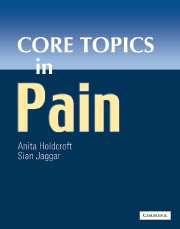Book contents
- Frontmatter
- Contents
- Contributors
- Preface
- Acknowledgements
- Foreword
- General abbreviations
- Basic science abbreviations
- PART 1 BASIC SCIENCE
- PART 2 PAIN ASSESSMENT
- Section 2a Pain measurement
- Section 2b Diagnostic strategies
- PART 3 PAIN IN THE CLINICAL SETTING
- Section 3a Clinical presentations
- Section 3b Pain syndromes
- PART 4 THE ROLE OF EVIDENCE IN PAIN MANAGEMENT
- PART 5 TREATMENT OF PAIN
- Section 5a General Principles
- Section 5b Physical treatments
- Section 5c Pharmacology
- Section 5d Psychosocial
- 44 Psychological management of chronic pain
- 45 Psychiatric disorders and pain
- 46 Chronic pain and addiction
- 47 The role of the family in children's pain
- 48 Palliative care
- PART 6 SUMMARIES
- Glossary
- Index
46 - Chronic pain and addiction
from Section 5d - Psychosocial
Published online by Cambridge University Press: 10 December 2009
- Frontmatter
- Contents
- Contributors
- Preface
- Acknowledgements
- Foreword
- General abbreviations
- Basic science abbreviations
- PART 1 BASIC SCIENCE
- PART 2 PAIN ASSESSMENT
- Section 2a Pain measurement
- Section 2b Diagnostic strategies
- PART 3 PAIN IN THE CLINICAL SETTING
- Section 3a Clinical presentations
- Section 3b Pain syndromes
- PART 4 THE ROLE OF EVIDENCE IN PAIN MANAGEMENT
- PART 5 TREATMENT OF PAIN
- Section 5a General Principles
- Section 5b Physical treatments
- Section 5c Pharmacology
- Section 5d Psychosocial
- 44 Psychological management of chronic pain
- 45 Psychiatric disorders and pain
- 46 Chronic pain and addiction
- 47 The role of the family in children's pain
- 48 Palliative care
- PART 6 SUMMARIES
- Glossary
- Index
Summary
In the management of chronic non-cancer pain (CNCP), there has been considerable controversy about the prevalence of addictive disorders. Published data of addiction in pain populations has cited prevalence rates as low as 0.0003% (Porter and Jick, 1980). This has been used in support of the argument that ‘addiction is so uncommon in the chronic pain patient as to not even merit looking for it’. While this statement is now largely tempered with the caveat, ‘in the absence of past history of substance abuse, or increased risk’, there is still a belief that addiction is not a problem in the chronic pain patient. This is clearly at odds with the prevalence of addiction within the general population; typically cited as 3–16% (Savage, 1996). One possible explanation for this is an inconsistency in the terms used to diagnose and describe addictive disorders. To this end, the Liaison Committee for Pain and Addiction (LCPA) was formed with members from the American Pain Society, the American Academy of Pain Medicine and the American Society of Addiction Medicine, to prepare acceptable definitions (Savage et al., 2001; Table 46.1) for dependency, tolerance and addiction.
Diagnosis of addiction in the pain patient
The diagnosis of addictive disorders within the chronic pain population is difficult. The Diagnostic and Statistical Manual for Mental Disorders-Fourth Edition (DSM-IV) (see Chapter 45) over represents the physical phenomena associated with substance use when defining dependence.
- Type
- Chapter
- Information
- Core Topics in Pain , pp. 305 - 310Publisher: Cambridge University PressPrint publication year: 2005



